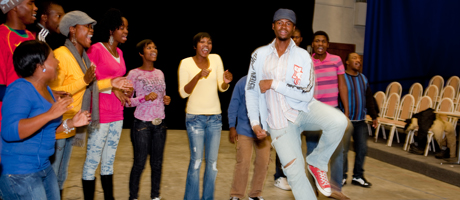By Julia Parmley
A dozen young adults from an impoverished South African community took center stage at GW’s Dorothy Betts Theatre Feb. 5 thanks to a partnership with GW. The performance featured traditional African songs and dances, as well as original poetry and a play, “Halfway to Somewhere,” about the definition of success.
“These young people are performing to give a sense of what their lives are like,” says GW Professor of Theatre Leslie Jacobson. “When you see them dance, and listen to their plays and poetry, you get a small picture of the incredible obstacles and challenges in their lives. Their spirit is remarkable, as is their willingness to share their feelings and their lives.”
The youth were at GW through the South Africa Project, a collaboration between the University, St. Andrews Episcopal School in Potomac, Md., and the Bokamoso Youth Centre in South Africa.
The young South Africans are from a poverty-stricken settlement northwest of Pretoria called Winterveld, where they participate in the Bokamoso Youth Centre. Founded in 1999 by South Africans Steven and Marion Carpenter, the center offers three-month programs that build life skills, including leadership and self-esteem building; teach HIV/AIDS awareness; and provide educational scholarships.
The center also offers a cultural exchange to the United States. Every January for the past six years, youth from the center have traveled to the United States to stay with St. Andrews host families and GW students and perform around the region.
“From the first year, their hosts fell in love with these kids and felt transformed by the interaction and exchange,” says Roy Barber, a music teacher at St. Andrews and the center’s youth drama coach. “Over the years the bonds have deepened. More than 200 St. Andrews students have visited the young people in their South African homes, and five GW students have worked intensively with them over summer break to help document their lives through theater, dance and filmed documentary.”
From Feb. 1 to Feb. 5, the South Africans stayed with GW students to practice for their performance on campus and get a taste of university life. Ms. Jacobson, along with center program director Solomon Mahlangu and GW senior Elizabeth Acevedo, helped coach the students for their performance, which will benefit the center.
This year’s play is about success and what it means to the South Africans. Ms. Jacobson says the act of creating plays is therapeutic for them. “There is a feeling that if you can make it out of Winterveld, you should,” says Ms. Jacobson. “These young people don’t necessarily feel that way, but they do feel forgotten, so this play looks at different ways of trying to define success.”
Ms. Jacobson first became involved with the center in 2003. Every year, she travels to South Africa to create plays with the youth centered around the issues that affect their lives, including family violence, rape and changing gender roles. “They lose hope, so Bokamoso is there to try and give them hope,” she says. “For many of these young people, this is the first time anyone has paid attention to them.”
Constance Rethusitsoe “Thusi” Mofuoa and Christopher Madikiza credit the center with providing them with the skills and support to succeed. “With this performance, we are showing what problems youth in South Africa have and what our obstructions are to being successful,” says Mr. Madikiza, who was recently offered an internship with D.C. Mayor Adrian Fenty. “We feel like our voices will be heard and our struggles acknowledged.”
“Through the center, I met and talked with people my age who understand my daily struggles and gave me the courage to carry on,” says Ms. Mofuoa. “I know I can make it despite poverty or anger in our society. You choose to be happy, and at Bokamoso, I find I can be happy.”
Mr. Mahlangu says the youth’s experience at GW has inspired them to continue pursuing their education. Last year, with the help of donations, the center was able to send 62 people to colleges in South Africa. “When the young people see American students with their big books, they are eager to do the same thing,” he says.
Mr. Mahlangu says he can “see the community changing.” “Most young people start to despair because they are trapped in a cycle of poverty, so Bokamoso is like an island of hope in a sea of despair to them,” he says. “As a community, we felt we needed to put something in place to help them and give them a second chance in life. By sharing their stories, they get healed.”
Comments? Criticism? The conversation continues. We welcome reactions, commentary and story recommendations on our Facebook page.


